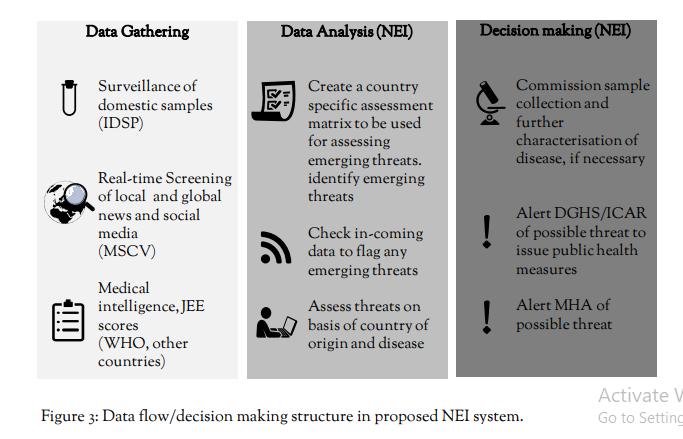A National Epidemic Intelligence Service for India
Plus, how Pakistan might use the Taliban, protecting gig workers, Columbus and Indian cuisine, and why China is building missile silos.
Dear Reader,
I hope you are doing well. Over the past week, our work included identifying mechanisms to protect the interests of gig workers on platforms like Swiggy, analysing the developments in Afghanistan from an Indian national security perspective, an exciting new research output on the creation of an epidemic intelligence service for India, and much more.
A National Epidemic Intelligence Service for India
The COVID-19 outbreak has demonstrated the need for India to develop its own capacity to assess emerging biological threats. Reliance on foreign inputs led to delayed actions such as airport closures or screening/quarantine of incoming travellers.
In a new research document,Ruturaj Gowaikar and Shambhavi Naik propose forming an Indian National Epidemic Intelligence (NEI) Service to monitor emerging outbreaks of novel or existing diseases, assess the threat in an Indian context, and alert public health agencies to take actions to protect Indian citizens. This service would build on India’s existing intelligence and surveillance units to create a network of trained personnel who can analyse incoming data, identify threats, secure biological samples and characterise pathogens.
Protecting India’s gig workers
Over the past few weeks, Twitter has been abuzz with allegations made by anonymous Twitter accounts, such as Swiggy DE and DeliveryBhoy, regarding issues faced by delivery partners of food delivery apps. These issues include low payouts, opaque payout calculations, and arbitrary measures to avoid return bonuses and incentive pay.
Mihir Mahajan and Anupam Manur wrote an op-ed in the Hindustan Times arguing that outdated mechanisms such as grievance redressal officers and stringent labour laws cannot address the issues raised by gig workers against the platforms that employ them. These platforms use machine-learning algorithms that assign specific orders to specific delivery executives based on various factors, such as weather, restaurant and customer locations, traffic and prevailing wages, to maximise profit.
These algorithms can have unintended outcomes. For instance:
A profit-maximising ML algorithm may deny orders to gig workers that are eligible for incentives, even without being programmed to do so. As a result, trust between the gig worker and the platform suffers.
The authors propose algorithm audits as a way to address these issues. Read the full oped to find out how these audits can help correct the power imbalance between platforms and gig workers.
How might Pakistan use the Taliban?
The Taliban’s takeover of Kabul is forcing India to reassess its aims and objectives concerning Afghanistan. Of primary interest is the impact of this development on Pakistan. Analysing this, Pranay Kotasthane wrote an article in the Times of India. He writes:
To understand what the Taliban's victory means for Pakistan — and hence India — it is useful to model Pakistan as two geopolitical entities, not one. The first entity is a seemingly normal Pakistani state, presumably concerned first and foremost with the peace and prosperity of its citizens. The second entity is what my colleague Nitin Pai has christened as the Pakistani military-jihadi complex (MJC). Comprising the military, militant, radical Islamist and political-economic nodes, the MJC pursues domestic and foreign policies to ensure its survival and dominance. For the MJC, positioning and defeating the existential enemy - India - is key to ensure its hold over the other Pakistan.
These two strands, Pranay argues, will view the developments in Afghanistan differently. The non-MJC Pakistan will be worried about the spillover of terrorism within Pakistan. The MJC, on the other hand, will perceive the Taliban’s resurgence as a strategic victory. As the latter’s foothold within Pakistan strengthens, its anti-India sentiment will grow stronger.
To prepare for the resulting increase in terrorism, India would need to strengthen its guard along the Pakistan border and bolster its partnership with the US. It’s key that India's relationship with the US remains stronger than the relationship that MJC has with the US.
China’s Missile Silos
In an expert explainer piece in the Indian Express, Suyash Desai wrote about China’s missile silos. Satellite images have revealed that China is building at least three missile silo fields. On completion of the ongoing work, China could have 250-270 new missile silos, more than 10 times the number it had maintained for several decades.
Suyash identifies three reasons why this could be happening. First, he argues:
This could be China’s attempt to move towards a launch-on-warning (LOW) nuclear posture. LOW refers to a launch at an adversary on detection of an incoming missile before the adversary’s missile hits its target.
Second, the development of new silos enables China to achieve its goal of increasing its nuclear warhead stockpile. Finally, it is possible that China could use these silos as decoys. Suyash writes:
The recently discovered silos could be an initiative to enhance deterrence by keeping the adversary guessing. This could be China’s shell game — where one, some, or all silos could have missiles, forcing the aggressor to target all of them during an escalation. The aggressor would have to waste more warheads or precision-guided weapons to destroy only a few missiles, or perhaps target empty silos.
This would be a cost-effective strategy for China, and could also bolster its image as serious nuclear power and an equal to the US.
Columbus and Indian cuisine
The arrival of the Portuguese and other European powers on India's shores profoundly impacted the subcontinent's militaries, polities, and societies - but also its food. In the 20th August episode of All Things Policy, Anirudh Kanisetti spoke to food blogger Sujata Shukla about how new crops from the Americas, often brought by Europeans, transformed Indian eating habits.
Why you should take our Health & Life Sciences programme
The Graduate Certificate in Public Policy (Health and Life Sciences), GCPP (HLS), is now ready for its 4th cohort. Students across countries and sectors have participated in the past three cohorts of the programme.
The Programme traverses a holistic path, analysing the interplay between the healthcare system and policies and webinars on Public Health, Gene Editing, Clinical Trials and Biobanking. Here's what Madhura Lohia, an alumna of the programme, has to say:
The first 5 weeks focus on the core modules and is common to all GCPP specialisations. It covers the fundamentals of public policy, economic reasoning for public policy and effective communication.
The second half of the programme deep-dives into the Health and Life Sciences specialisation. The curriculum is carefully curated and vetted by Shambhavi Naik and her team at Takshashila to ensure relevant and engaging topics.
The highlight of the specialisation is the 2nd workshop, the Policy Simulation Exercise. It is meant to engage students in solving a real-life policy problem. During the three day workshop, the students are divided into teams that compete to propose viable policy solutions to the problem.
That reminds me:


What we have been reading
The last book we recommended was The Third Pillar by Dr Raghuram Rajan. I hope you have been enjoying reading it. This week’s book, recommended by Shrey Khanna, is The Taliban at War: 2001–2018 by Antonio Giustozzi. Shrey says:
Antonio Giustozzi details Taliban’s military and organisational history in The Taliban at War, 2001-2018. Giustozzi highlights Taliban's patterns of recruitment, their strategy and tactics, including how the leadership responded to the evolving nature of insurgency.
The author shows that the transformation of the Taliban movement into an insurgency in 2002 created a polycentric organisation as the militants who gradually joined the insurgency organised themselves into separate Shuras – Peshawar Shura, Mashhad Shura, Miranshah Shura – which demanded autonomy from the Quetta Shura. In the process, Giustozzi details how the funding from Pakistan, Iran, Saudi Arabia, China and Russia amounted to more than two-thirds of the total revenue of the newly created Shuras. He also highlights that after the withdrawal of the bulk of foreign troops in 2014, the Taliban had to implement painstaking reforms as the changed nature of war required them to operate under a single chain of command to mount large-scale concentrated attacks on the population centres as opposed to a Guerrilla insurgency.
Read!
That’s it from us this week. Take care and stay safe.
Regards,
Atish Padhy,
Assistant Manager, Digital Properties,
Takshashila Institution


